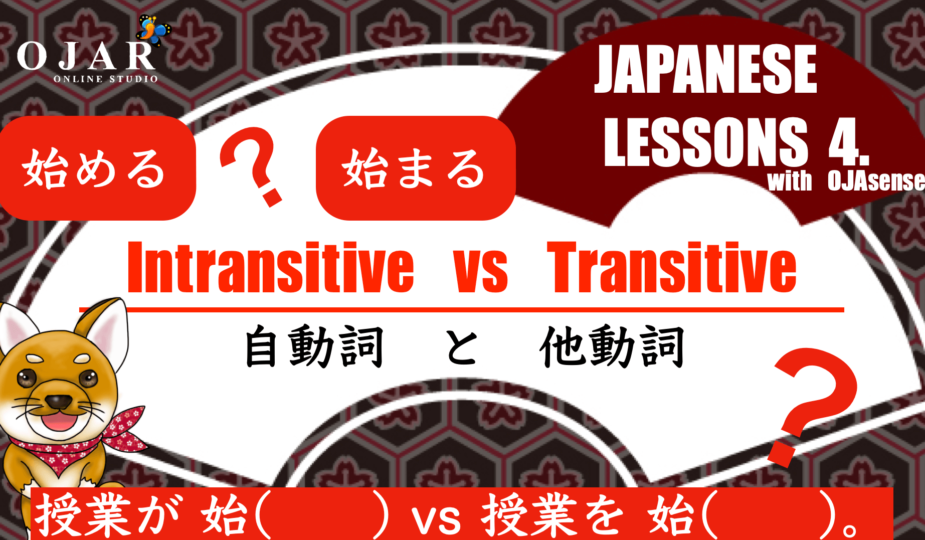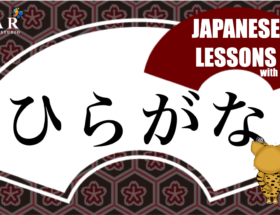Hi, ojachan is here. 😄 Today’s lesson is: Japanese Lesson 15: Intransitive Verbs vs Transitive Verbs ( Jidoushi vs Tasoushi )!
Don’t you want to know how to learn Japanese like Japanese kids? This lesson is meant for students that are beginners at Japanese.
Memorizing verbs by classifying and understanding the difference between an intransitive verb and a transitive verb are very important.
Usually, though Japanese learners learn this grammar in lesson 29 of Minna no Nihongo, I think it’s good for beginner’s level of Japanese learner to learn them now.
The reason why is because it’s essential knowledge to know the usage particle “を wo” and particle “が ga”. Besides you can understand easier and use correct Japanese earlier. There are some type of words in English like “to rise or to raise” and “to lay or to lie”.
So let’s get started!
A Dictionary of Basic Japanese Grammar
| Amazon Reviews: | ★★★★★ |
|---|
★ Level: Elementary
★ Genre: Grammar
★ Language: English is used for grammar explanations and translations of example sentences.
★ Number of entries: 206
★ Example sentences are written in kanji/kana with romanization.
Publisher: JAPAN TIMES
CONTENTS
Intransitive Verbs and Transitive Verbs
Intransitive verbs can follow “が ga” or “は wa”, and transitive verbs follow “を wo” or “に ni”. An intransitive verb, which is called “自動詞 jidoushi”, can show an action or an effect by the subject. “自動 jidou” means “automation”.
For example, “行く iku to go”, “走る hashiru to run” and “勉強する benkyousuru to study” etc are intransitive verbs.
And we use for the things occurred spontaneously, “流れる nagareru to flow”, “消える kieru to go off” and “燃える moeru to burn” are also intransitive verbs.
While, a transitive verb, which is called “他動詞 tadoushi”, works for others.
For example, “閉める shimeru to close something”, “消す kesu to turn off something” and “壊す kowasu to break something” etc are transitive verbs.
In other words, they can’t move if the things are affected by others.
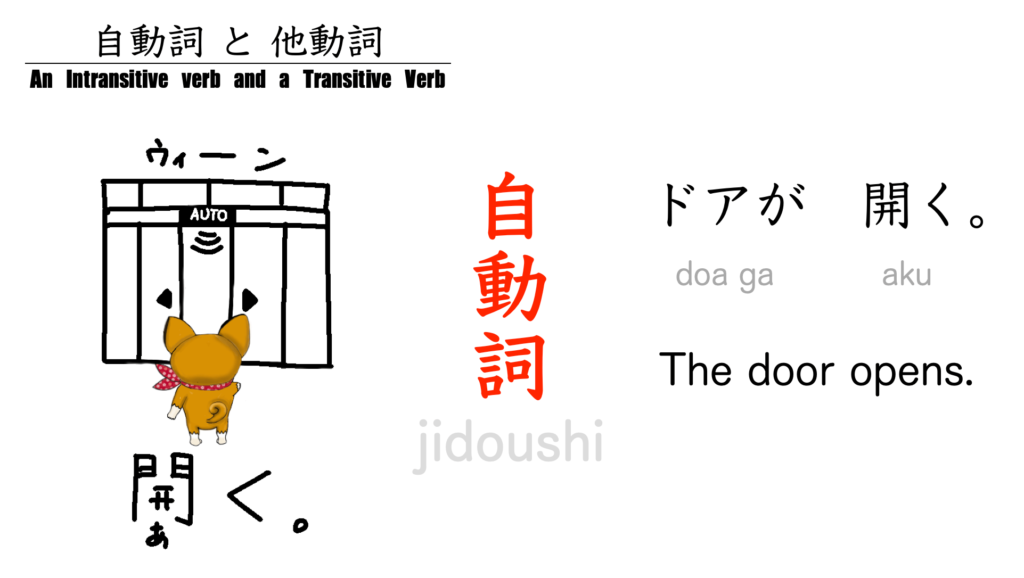
“To open” as an intransitive verb is the door opens automatically.
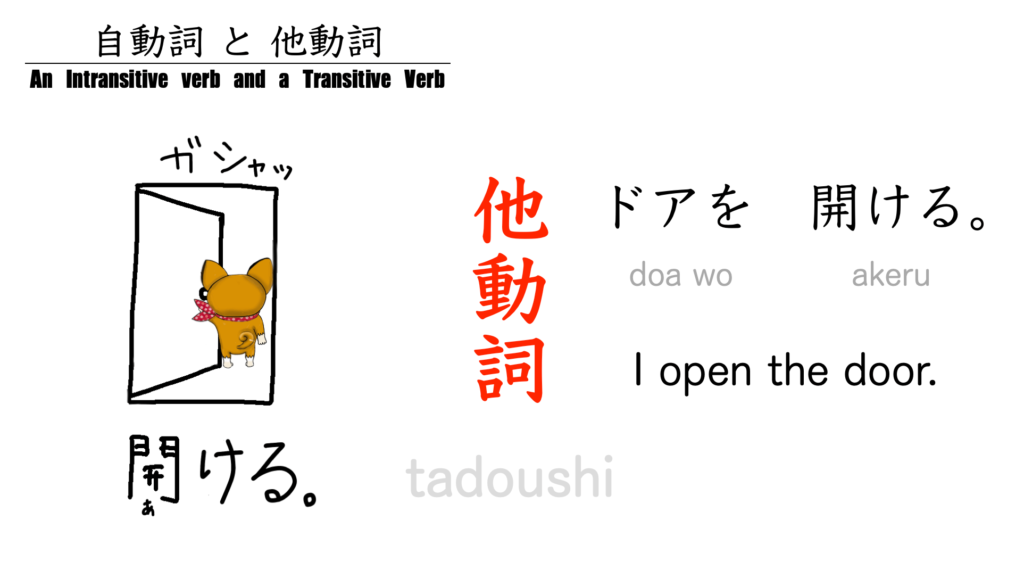
“To open” as a transitive verb is the door is opened by Shibachan.
Additionally, “開く hiraku to open” can use for both of them.
We use 開く for the transformation from the closed state to the open state.
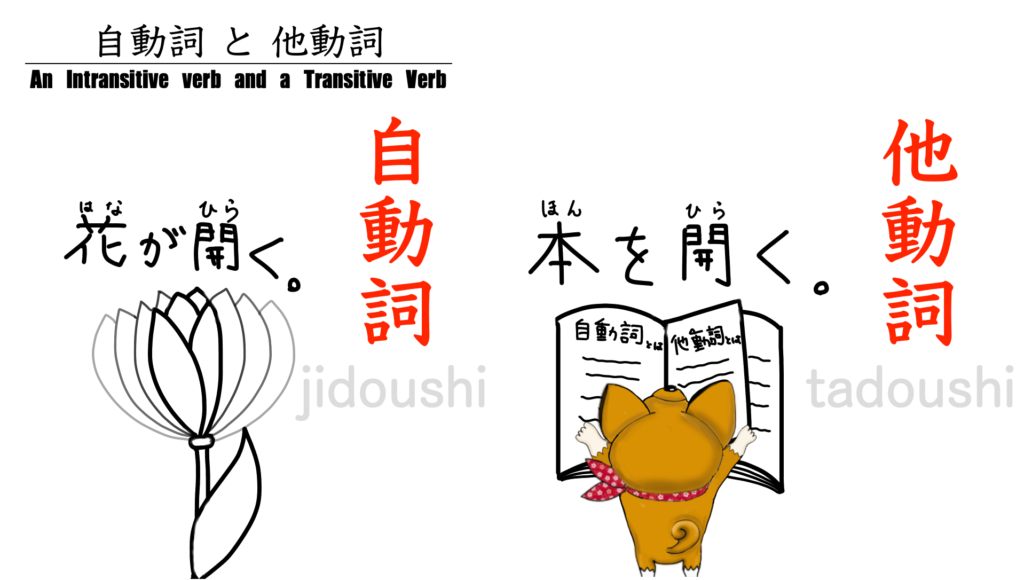
| 自動詞 jidoushi intransitive verbs | 他動詞 tadoushi transitive verbs |
| 花が 開く。 hana ga hiraku The flowers open. | 本を 開く。 hon wo hiraku I open the book. |
| 花が 閉じる。 hana ga tojiru The flowers close. | 本を 閉じる。 hon wo tojiru I close the book. |
| 会社に 急ぐ。 kaisha ni isogu I hurry to my office. | 仕事を 急ぐ。 shigeto wo isogu I hurry a job. |
In this way, there are some verbs which can be both intransitive verbs and transitive verbs.
You can recognize them by paying attention for intransitive verbs can follow the particle “が ga” and “は wa” or transitive verbs can follow the particle “を wo” and “に ni”.
自動詞 Intransitive verbs
1. Be careful for particles
However, you should be careful the idea of the meaning; the verb following “が”, so it’s an intransitive verb, and the verb following “を” , so it’a transitive verb.
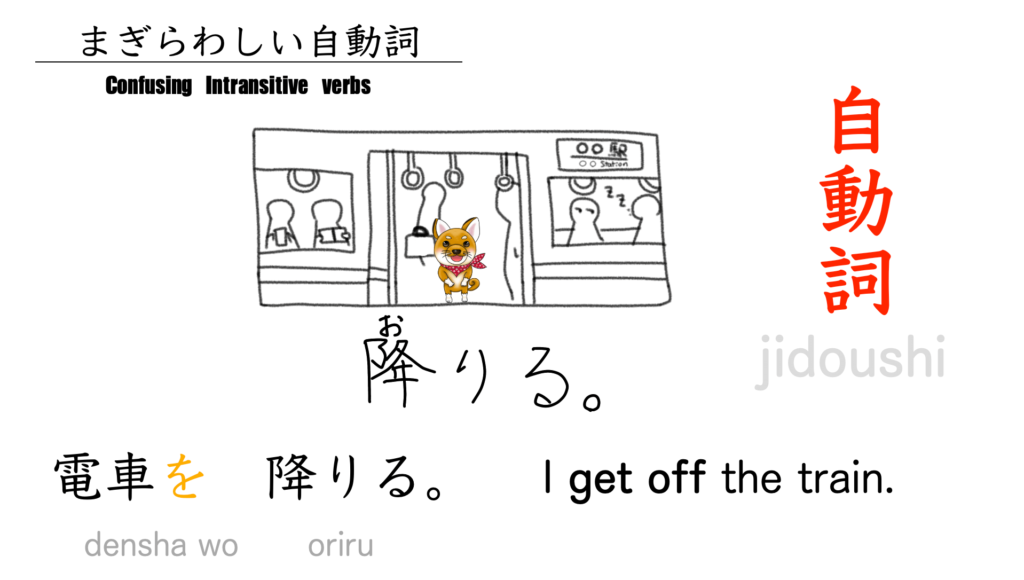
“降りる to get off” is an intransitive verb.
降りる oriru to get off
e.g. 自転車を 降ります。
jitensha wo orimasu
I get off from the bicycle.
乗る noru to get on
e.g. 車に 乗ります。
kuruma ni norimasu
I get on the car.
These words are intransitive verbs though, they don’t following “が”.
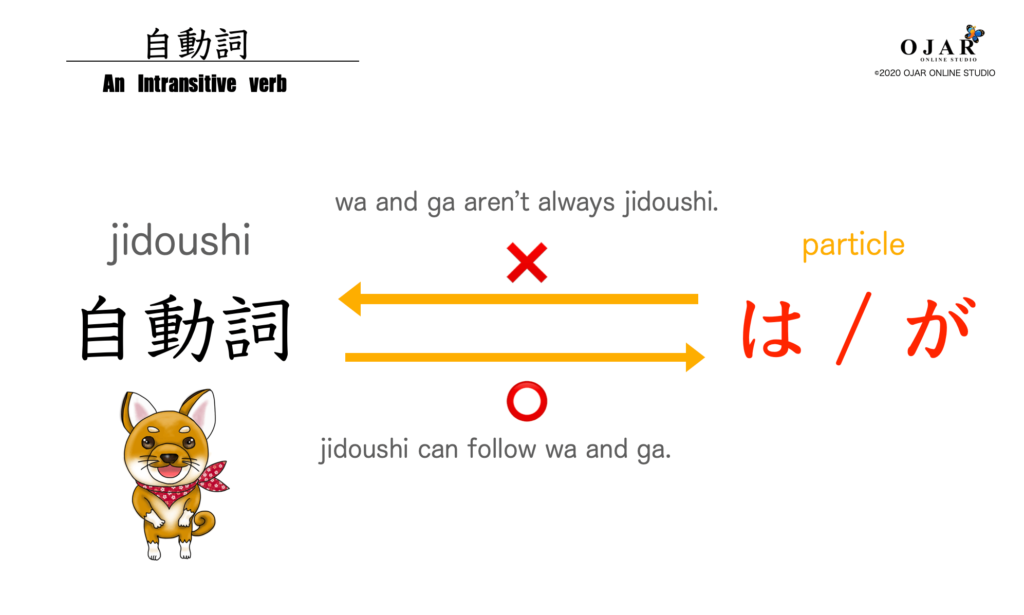
Intransitive verbs are just an action or an effect by the subject, and transitive verbs just works for others or are affected by others.
I’m going to write about “the difference between を and が” next time!
2. Verbs Being Only Intransitive Verbs
There are a lot of verbs to be only intransitive verbs like this. And this type of verbs are called “無対自動詞 mutsui-jidoushi”.
■ Motion Verbs
Plus, “行く iku to go”, “帰る kaeru to go back” and “来る kuru to come” etc, called “移動動詞 idou-doushi motion verbs”, are intransitive verbs.
行く iku to go
e.g. 学校に 行きます。
gakkou ni ikimasu
I go to school.
来る kuru to come
e.g. 友達は 家に 来ます。
tomodachi wa koko ni kimasu
My friend will come to my house.
走る hashiru to run
e.g. 家の近くを 走ります。
ie no chikaku wo hashirimasu
I run near my house.
歩く aruku to walk
e.g. 公園で 歩きます。
kouen de arukimasu
I walk at the park.
■ Being Only Intransitive Verbs
Here is the verbs which can be only intransitive verbs!
いる iru to exist (creature)
e.g. 猫が います。neko ga imaru
There is a cat.
ある aru to exist (object)
e.g. 本が あります。
hon ga arimasu
There is a book.
なる naru to become
e.g. 先生に なる。
sensei ni narimasu
I become a teacher.
動く ugoku to move
e.g. ロボットが 動きます。
robotto ga ugokimasu
The robot moves.
泳ぐ oyogu to swim
e.g. プールで 泳ぎます。
puuru de oyogimasu
I swim in the pool.
座る suwaru to sit
e.g. ソファに 座ります。
sofa ni suwarimasu
I sit on the sofa.
住む sumu to live
e.g. 日本に 住みます。
nihon ni sumimasu
I live in Japan.
泣く naku to cry
e.g. わたしは 泣きました。
watashi wa nakimashita
I cried.
笑う warau to laugh
e.g. わたしは 笑いました。
watashi wa waraimashita
I laughed.
成長する seichousuru to grow up
e.g. 子供が 成長します。
kodomo ga seichou shimasu
My kids grow up.
会う au to meet / to see
e.g. 家族に 会います。
kazoku ni aimasu
I’m going to see my family.
別れる wakareru to part / to break up
e.g. 彼女と 別れました。
kanojo to wakaremashita
I broke up with my girlfriend.
気づくkizuku to notice
e.g. 間違いに 気づきました。
machigai ni kizukimashita
I noticed my mistake.
勝つ katsu to win
e.g. 試合に 勝ちました。
shiai ni kachimashita
I won the game.
負ける makeru to loose
e.g. 勝負に 負けました。
shoubu ni makemashita
I lost the fight.
他動詞 Transitive Verbs
“読む yomu to read “ , “書く kaku to write” and “話す hanasu to speak” are transitive verbs.
But there are also some verbs which can only be transitive verbs. They are called “無対他動詞 mutsui-tadoushi”.
When Japanese people learn transitive verbs of English, we learn with を like “~を読む” or “~を書く” because transitive verbs are always following particle を.
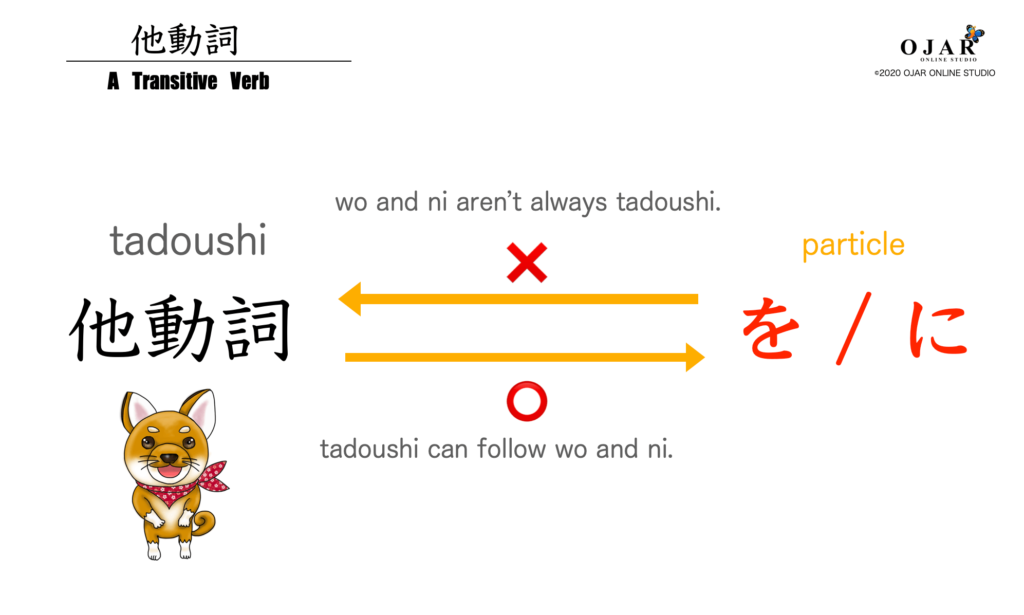
読む yomu to read
e.g. わたしは 新聞を 読みます。
watashi wa shinbun wo yomimasu
I read the newspaper.
書く kaku to write
e.g. わたしは 日記を 書きます。
watashi wa nikki wo kakimasu
I write my diary.
感じる kanjiru to feel
e.g. わたしは 痛みを 感じます。
watashi wa itami wo kanjimasu
I feel pain.
疑う utagau to dubt
e.g. わたしは あなたを 疑っています。
watashi wa anata wo utagatte imasu
I am doubting you.
休む yasumu to take a rest [break] / take a day off
e.g. わたしは 会社を 休みました。
watashi wa kaisha wo yasumimashita
I took my day off.
知る shiru to know
e.g. わたしは この意味を 知りました。
watashi wa imi wo sirimasita
I know this meaning.
嫌う kirau to dislike
e.g. 私の父は 動物を 嫌います。
watashi no chichi wa doubutsu wo kiraimasu.
My father dislikes animal.
願う negau to wish
e.g. 幸福を 願います。
koufuku wo negaimasu
I wish you happiness.
望む / 希望する nozomu /kibousuru to hope
e.g. 空港で 荷物の 受け取りを 希望します。
kuukou de nimotsu no uketori wo kiboushimasu
I hope I can get the luggage at the airport.
教える oshieru to teach
e.g. わたしは 英語を 教えます。
watashi wa eigo wo oshiemasu
I teach English.
考える / 思う kangaeru / omou to think
e.g. わたしは 今夜の 夕食を 考えます。
watashi wa yuushoku wo kangaemasu
I think my dinner tonight.
忘れる wasureru to forget
e.g. 教科書を 忘れました。
kyoukasho wo wasuremashita
I forgot my textbook.
You see, transitive verbs are always following particle を.
How to Conjugate from Jidoushi to Tadoushi
Let’s learn how to make from intransitive verbs to transitive verbs.
The stems are same, but the suffixes are different.
Unfortunately, you need to memorize the verbs even though the verbs have several patterns. It’s similar to irregular verbs of English like “know-knew-known”.
Simply, almost all of verbs can conjugate Group1 verbs to group 2 verbs, especially shimo-ichidan-katsuyou.
Read this if you don’t know how to classifying verbs.
I’m going to introduce you how to conjugate a word from jidoushi to tadoushi.
*The names of pattern are not official, they are my original by the way.
1. 5-5 form
・-u 五段活用 → -asu 五段活用
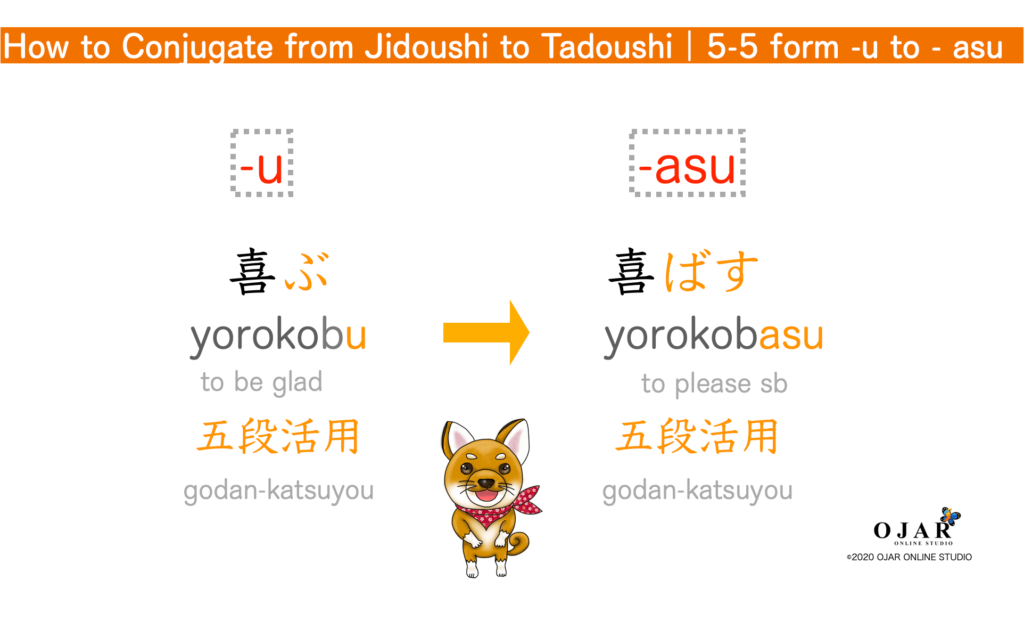
| Jidoushi Intransitive Verbs -u 五段活用 | English | Tadoushi Transitive Verbs -asu 五段活用 | English |
|---|---|---|---|
| 減る heru | to decrease | 減らす herasu | to reduce sth |
| 沸く waku | to boil | 沸かす wakasu | to boil sth |
| 乾く kawaku | to dry | 乾かす kawakasu | to dry sth |
| 喜ぶ yorokobu | to be glad | 喜ばす yorokobasu | to please sb |
・-ru 五段活用 → -su 五段活用
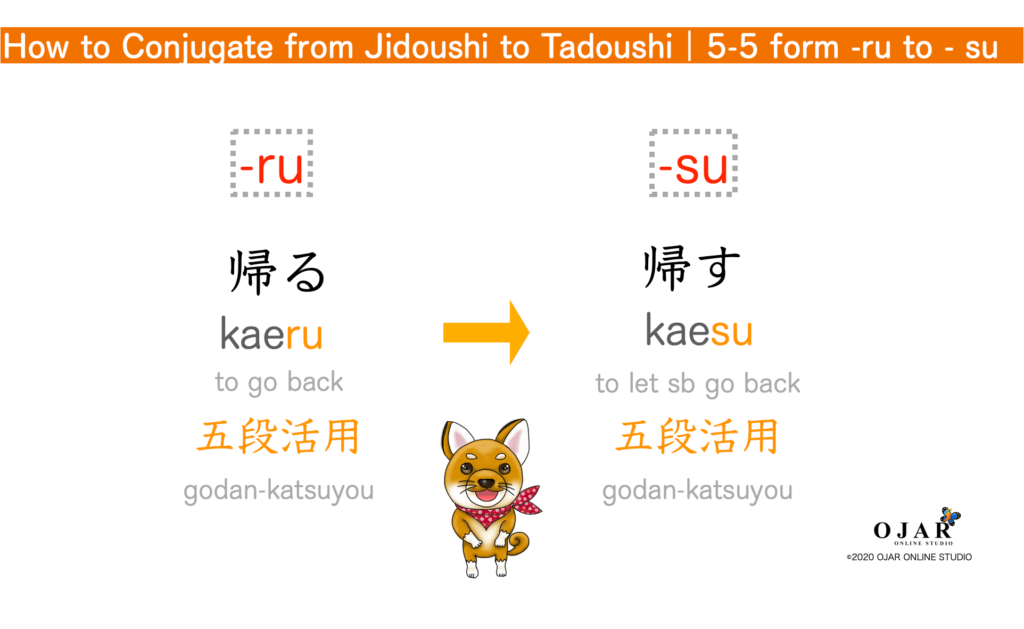
| Jidoushi Intransitive Verbs -ru 五段活用 | English | Tadoushi Transitive Verbs -su 五段活用 | English |
|---|---|---|---|
| 帰る kaeru | to go back | 帰す kaesu | to let sb go back |
| 返る kaeru | to give back | 返す kaesu | to return sth |
| 通る tooru | to go through | 通す toosu | to pass sth / pl |
| 回る mawaru | to rotate | 回す mawasu | to rotate sth |
| 直る naoru | to be fixed | 直す naosu | to fix sth |
| 渡る wataru | to cross | 渡す watasu | to pass sth |
2. 5-eru form
・-aru 五段活用→ -eru 下一段活用
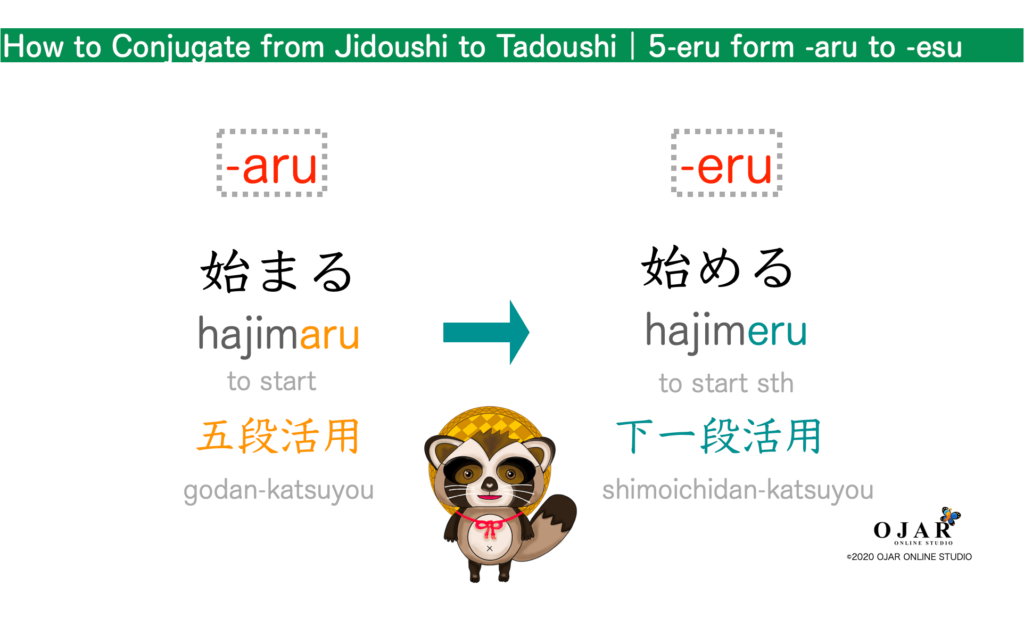
| Jidoushi Intransitive Verbs -aru 五段活用 | English | Tadoushi Transitive Verbs -eru 下一段活用 | English |
|---|---|---|---|
| 上がる agaru | to rise | 上げる ageru | to raise sth |
| 決まる kimaru | to be decided | 決める kimeru | to decide sth |
| 閉まる shimaru | to be closed | 閉める shimeru | to close sth |
| 集まる atsumaru | to gather | 集める atsumeru | to collect sth |
| 始まる hajimaru | to start | 始める hajimeru | to start sth |
| 見つかる mitsukaru | to be found | 見つける mitsukeru | to find sth |
| 掛かる kakaru | to hang | 掛ける kakeru | to hang sth |
| 助かる tasukaru | to be saved | 助ける tasukeru | to help sb |
| 止まる tomaru | to stop | 止める tomeru | to stop sth |
| 曲がる magaru | to bend | 曲げる mageru | to bend sth |
| 混ざる mazaru | to mix | 混ぜる mazeru | to mix sth |
| 固まる katamaru | to harden | 固める katameru | to harden sth |
・-u 五段活用 → -eru 下一段活用
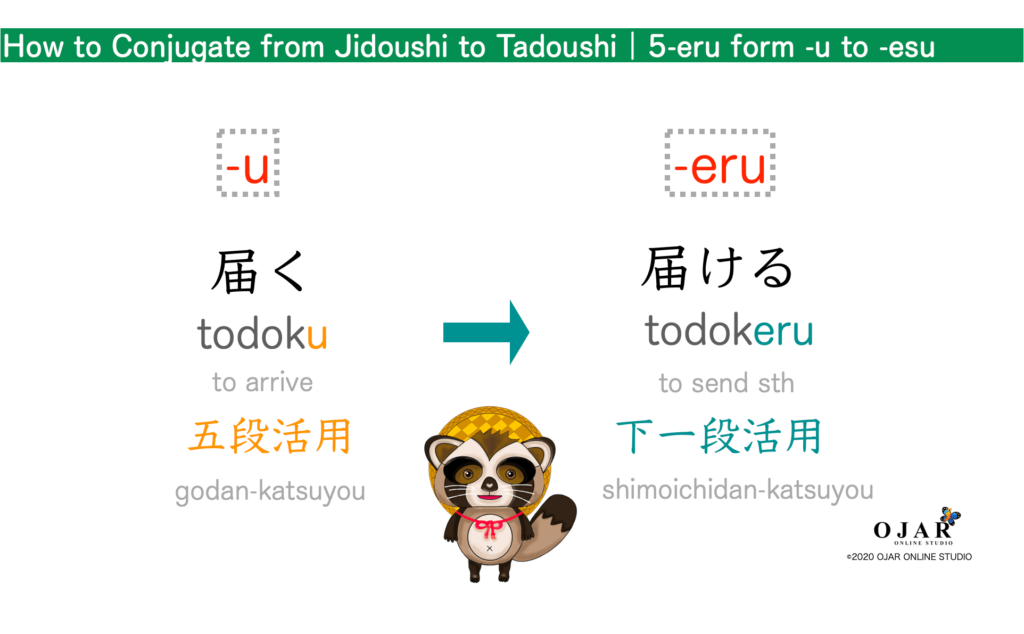
| Jidoushi Intransitive Verbs -u 五段活用 | English | Tadoushi Transitive Verbs -eru 下一段活用 | English |
|---|---|---|---|
| 開く hiraku | to open | 開ける akeru | to open sth |
| 届く todoku | to arrive | 届ける todokeru | to send sth |
| 育つ sodatsu | to grow | 育てる sodateru | to grow sth |
| 立つ tatsu | to stand | 立てる tateru | to stand sth |
| 並ぶ narabu | to line up | 並べる naraberu | to display |
| 進む susumu | to proceed | 進める susumeru | to move forward sth |
| 付く tsuku | to stick | 付ける tsukeru | to stick sth |
| 続く tsuzuku | to continue | 続けるtsuzukeru | to keep sth |
・-ru 五段活用 → -seru 下一段活用
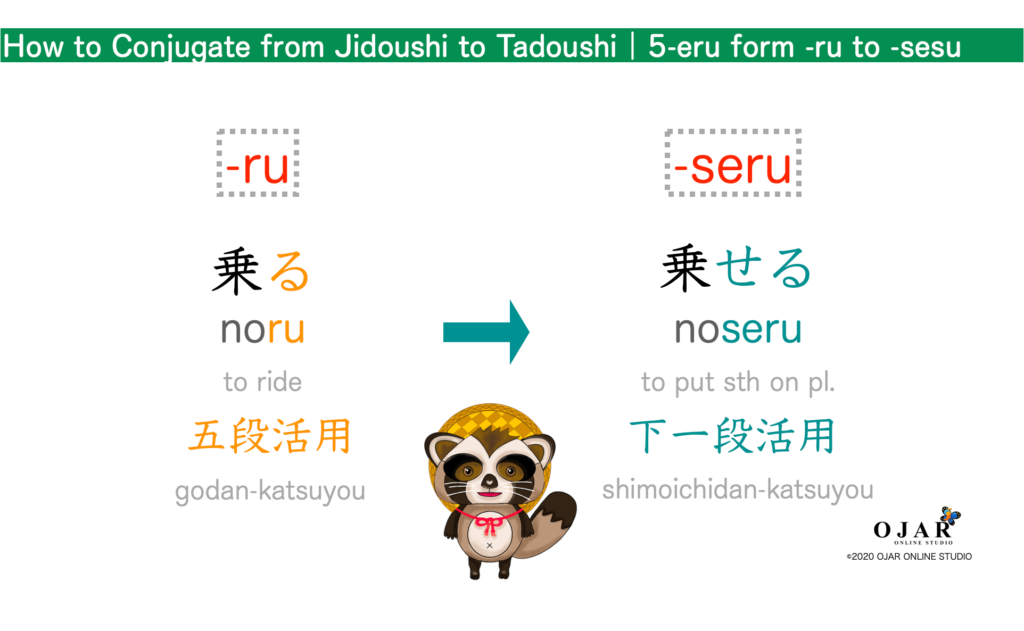
| Jidoushi Intransitive Verbs -ru 五段活用 | English | Tadoushi Transitive Verbs -seru 下一段活用 | English |
|---|---|---|---|
| 乗る noru | to ride | 乗せる noseru | to put sth on pl. |
| 寄る yoru | to approach | 寄せる yoseru | to approach sth / pl |
・-waru 五段活用 → -eru 下一段活用
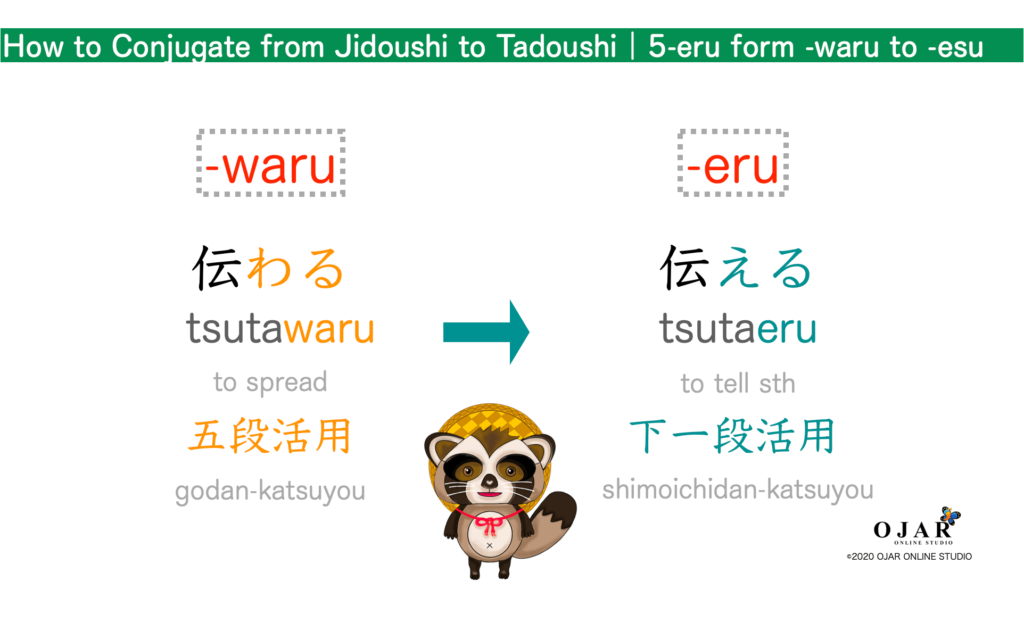
| Jidoushi Intransitive Verbs -waru 五段活用 | English | Tadoushi Transitive Verbs -eru 下一段活用 | English |
|---|---|---|---|
| 変わるkawaru | to change | 変えるkaeru | to change sth |
| 加わるkuwawaru | to join | 加えるkuwaeru | to add sth |
| 伝わるtsutawaru | to spread | 伝えるtsutaeru | to tell sth |
3. eru-5 form
・-eru 下一段活用 → -asu 五段活用
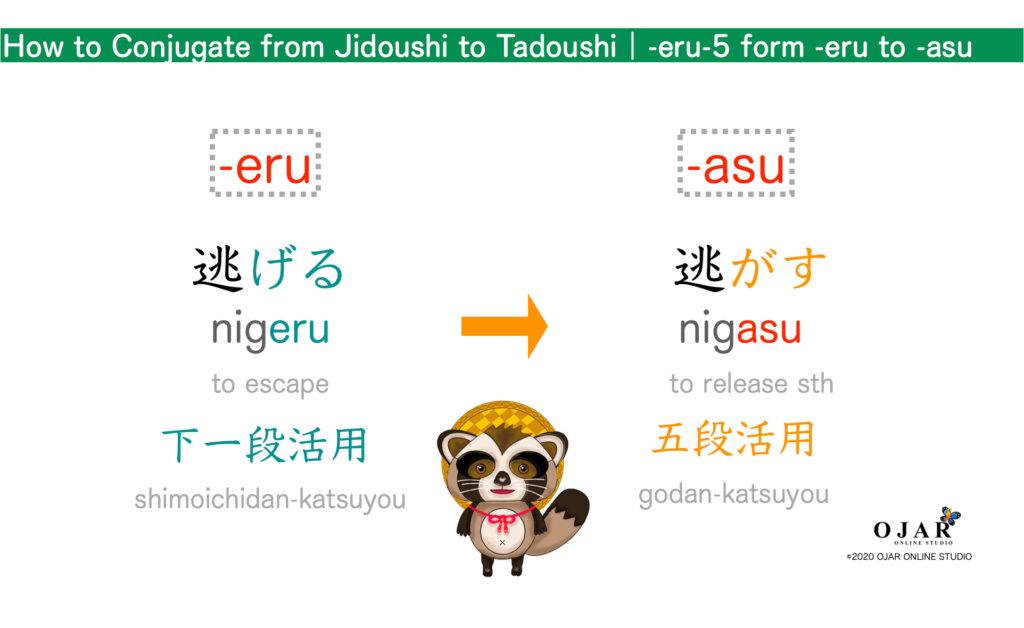
| Jidoushi Intransitive Verbs -eru 下一段活用 | English | Tadoushi Transitive Verbs -asu 五段活用 | English |
|---|---|---|---|
| 出る deru | to go out | 出す dasu | to hold sth out |
| 逃げる nigeru | to escape | 逃がす nogasu | to release sth |
| 溶ける tokeru | to melt | 溶かす tokasu | to melt sth |
| 枯れる kareru | to wither | 枯らす karasu | to wither sth |
・-eru 下一段活用 → -u 五段活用
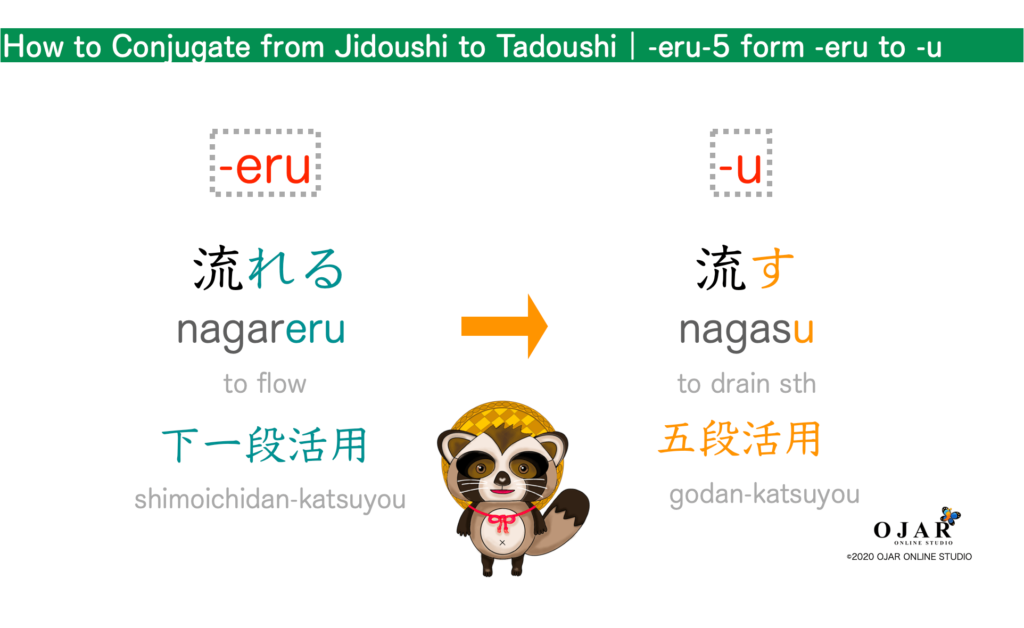
| Jidoushi Intransitive Verbs -eru 下一段活用 | English | Tadoushi Transitive Verbs -u 五段活用 | English |
|---|---|---|---|
| 取れる toreru | to be obtained | 取る toru | to obtrain sth |
| 切れる kireru | to be cut | 切る kiru | to cut sth |
| 破れる yabureru | to be broken | 破る yaburu | to tear sth |
| 折れる oreru | to be broken | 折る oru | to fold sth |
| 割れる wareru | to be cracked | 割る waru | to divide sth |
| ほどける hodokeru | to undone | ほどく hodoku | to undo sth |
| 脱げる nugeru | to come off | 脱ぐ nugu | to take sth off |
| 焼ける yakeru | to be burned | 焼く yaku | to bake sth |
| 売れる ureru | to be sold | 売る uru | to sell sth |
| 抜ける nukeru | to come out | 抜く nuku | to pull sth out |
| 解ける tokeru | to be solved | 解く toku | to solve sth |
| 流れる nagareru | to flow | 流す nagasu | to drain sth |
・-reru 下一段活用 → -su 五段活用
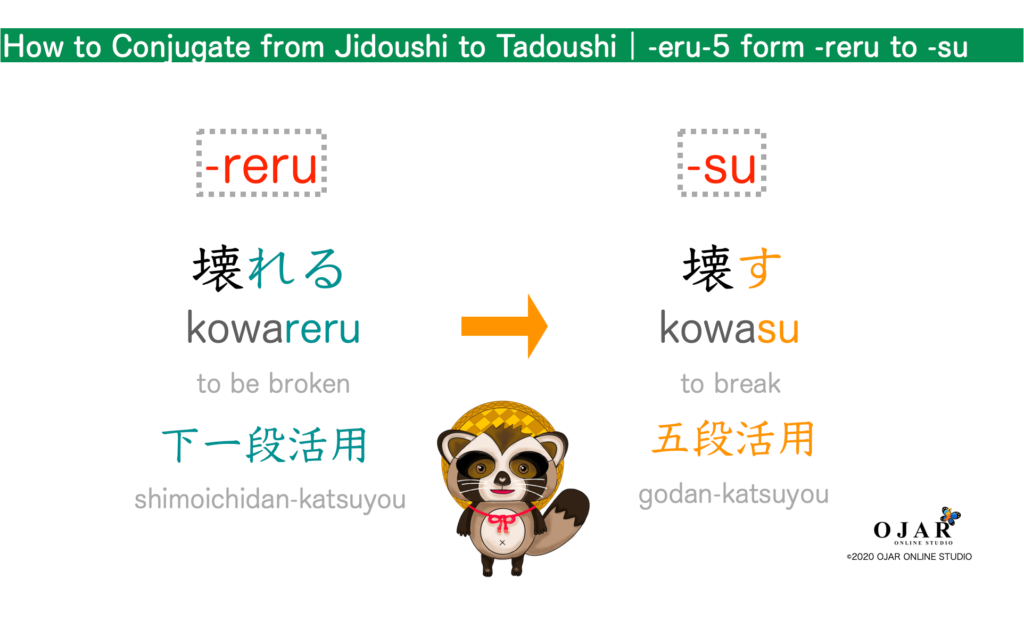
| Jidoushi Intransitive Verbs -reru 下一段活用 | English | Tadoushi Transitive Verbs -su 五段活用 | English |
|---|---|---|---|
| 潰れる tsubureru | to be crushed | 潰す tsubusu | to crush sth |
| 離れる hanareru | to separate | 離す hanasu | to separate sth |
| 外れる hazureru | to come off | 外す hazusu | to take sth |
| 倒れる taoreru | to fall down | 倒す taosu | to throw sth down |
| 汚れる yogoreru | to get dirty | 汚す yogosu | to make sth dirty |
| 現れる arawareru | to show up | 現す arawasu | to show sth |
| 壊れる kowareru | to be broken | 壊す kowasu | to break sth |
・-eru 下一段活用 → -yasu 五段活用
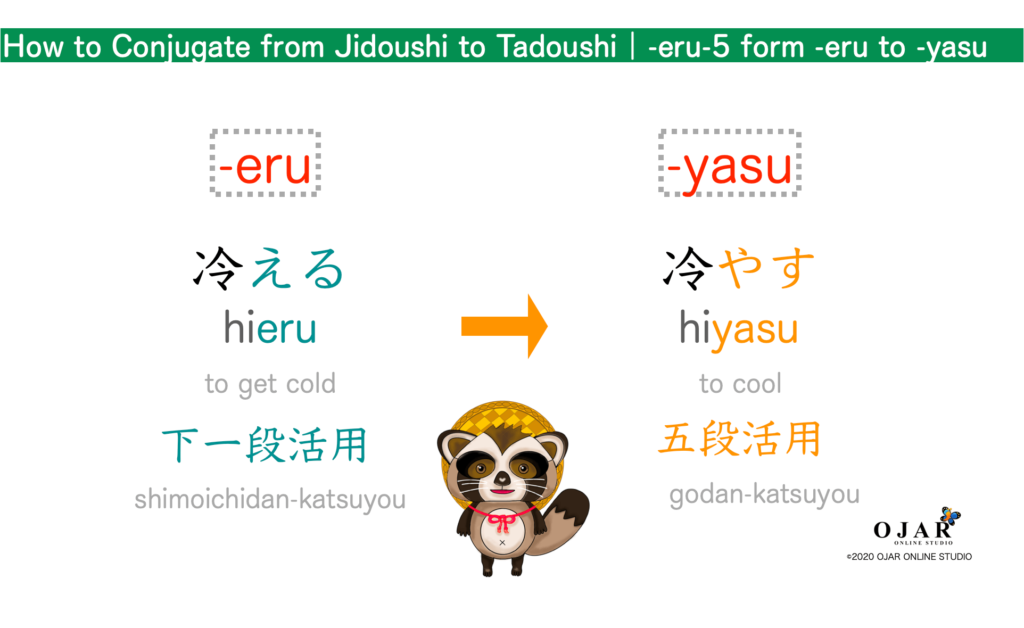
| Jidoushi Intransitive Verbs -eru 下一段活用 | English | Tadoushi Transitive Verbs -yasu 五段活用 | English |
|---|---|---|---|
| 増える fueru | to increase | 増やす fuyasu | to increase sth |
| 冷える hieru | to get cold | 冷やす hiyasu | to cool sth |
| 生える haeru | to grow | 生やす hayasu | to grow sth |
| 燃える moeru | to burn | 燃やす oyasu | to burn sth |
4. iru-5 form
・-iru 上一段活用 → -osu 五段活用
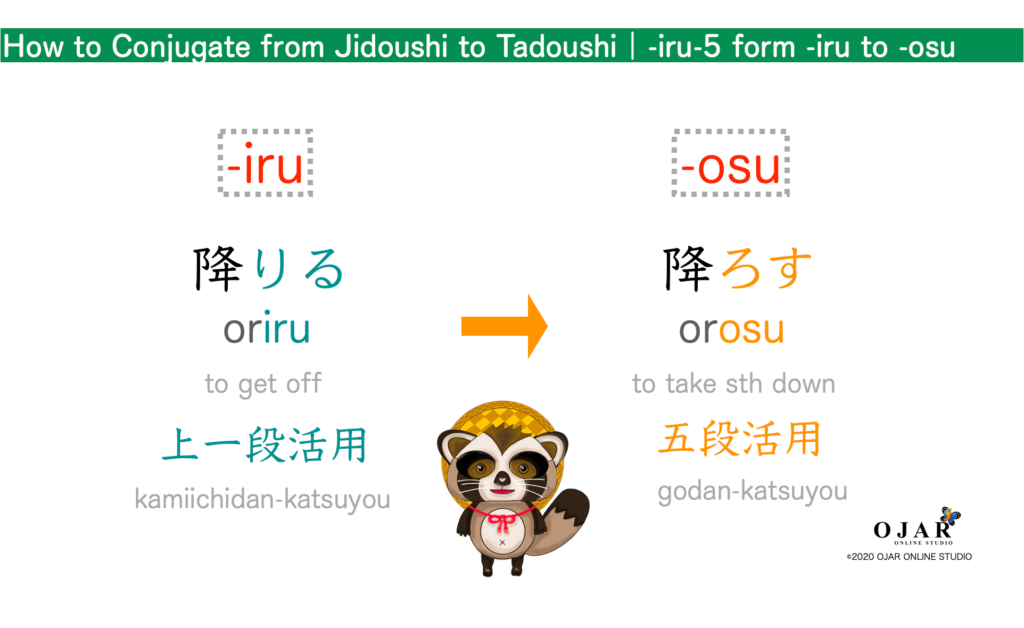
| Jidoushi Intransitive Verbs -iru 上一段活用 | English | Tadoushi Transitive Verbs -osu 五段活用 | English |
|---|---|---|---|
| 起きる okiru | to wake up | 起こす okosu | to wake sb up |
| 降りる oriru | to get off | 降ろす orosu | to take sth down |
| 落ちる ochiru | to fall | 落とす otosu | to fall sth |
| 過ぎる sugiru | to pass | 過ごす sugosu | to spend sth |
5. Others
| Jidoushi Intransitive Verbs | English | Tadoushi Transitive Verbs | English |
|---|---|---|---|
| 見える mieru 下一段活用 | to see | 見る miru 上一段活用 | to look at sth |
| 入る hairu | to come in | 入れる ireru | to put sth |
| 聞こえる kikoeru | to hear | 聞く kiku | to listen to sth |
| 消える kieru | to disappear | 消す kesu | to turn off sth |
| 分かれる wakareru | to divide | 分ける wakeru | to divide sth |
| 終わる owaru | to end | 終える oeru 終わる owaru | to finish sth |
A Dictionary of Basic Japanese Grammar
| Amazon Reviews: | ★★★★★ |
|---|
★ Level: Elementary
★ Genre: Grammar
★ Language: English is used for grammar explanations and translations of example sentences.
★ Number of entries: 206
★ Example sentences are written in kanji/kana with romanization.
Publisher: JAPAN TIMES
Intransitive vs Transitive QUIZ
Okay, that’s all for today!
Good luck with your Japanese study 😉
P.S. My English skill is not enough yet. Please correct me with DM from CONTACT if my English is wrong. Thank you for your cooperation!
Next Lesson is;
Japanese Lesson 16:Verb Conjugations Group 3
Previous Lesson is; CLICK HERE!
Japanese Lesson 14: Verbs (with fully clear illustrations)

